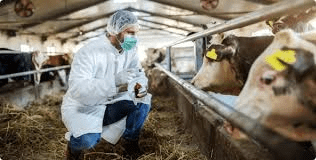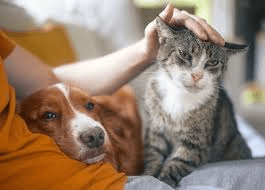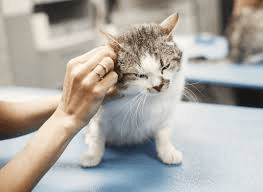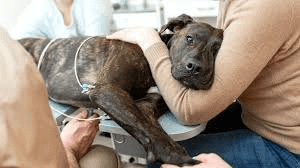Animals, like humans, can suffer from various health issues throughout their lives. Identifying and addressing these ailments promptly is crucial for ensuring their well-being.
Understanding common health problems, implementing preventive measures, and knowing the appropriate treatments can help keep pets and livestock healthy and happy.
Identifying Common Animal Health Issues
Recognizing health issues in animals requires observation and understanding of normal behavior. Here are some common health problems to watch for:
1. Digestive Problems: Animals can experience issues such as diarrhea, vomiting, or constipation. These problems may result from dietary changes, infections, or underlying conditions.
2. Respiratory Issues: Coughing, sneezing, and difficulty breathing are signs of respiratory problems. These issues can be caused by infections, allergies, or environmental factors.
3. Skin and Coat Conditions: Animals may develop skin problems like itching, redness, or hair loss. These conditions can be due to allergies, parasites, or infections.
4. Behavioral Changes: Changes in behavior, such as lethargy, aggression, or loss of appetite, can indicate health issues. It’s important to monitor any unusual behavior closely.
5. Weight Changes: Sudden weight loss or gain can signal health problems. Consistent monitoring of an animal’s weight helps in early detection of potential issues.
Preventive Measures and Routine Care

Regular care and preventive measures play a significant role in maintaining animal health and preventing illness. Here are some essential practices:
1. Regular Check-Ups: Schedule routine veterinary check-ups to monitor your animal’s health and catch any potential issues early. Annual exams are usually recommended.
2. Vaccinations: Ensure your animal receives the necessary vaccinations to protect against common diseases. Follow your veterinarian’s vaccination schedule.
3. Proper Nutrition: Provide a balanced diet appropriate for your animal’s age, size, and health condition. Consult your vet to choose the best food and avoid overfeeding.
4. Hygiene: Maintain good hygiene practices, such as regular grooming and clean living environments, to prevent infections and parasites.
5. Exercise: Ensure your animal gets regular exercise to keep them physically fit and mentally stimulated. Exercise needs vary depending on the species and breed.
6. Parasite Control: Use recommended products to control fleas, ticks, and other parasites. Regularly check for signs of infestation and consult your vet for treatment options.
Treatment Options for Digestive Problems
Digestive issues in animals can vary from mild to severe. Here’s how to address them:
1. Assess Diet: Review your animal’s diet and make sure they are not consuming anything that could cause digestive upset. Sudden dietary changes should be avoided.
2. Hydration: Ensure your animal has access to fresh water at all times. Dehydration can be a serious concern with digestive problems.
3. Monitor Symptoms: Keep track of symptoms like diarrhea, vomiting, or constipation. If symptoms persist for more than 24-48 hours, contact your veterinarian.
4. Medications: Your vet may prescribe medications to address specific issues such as parasites, infections, or inflammation. Always follow their instructions.
5. Probiotics: In some cases, probiotics can help restore healthy gut flora and improve digestion. Consult your vet before adding these to your animal’s diet.
6. Special Diets: For chronic digestive problems, your vet may recommend a special diet tailored to your animal’s needs. Follow their guidance to manage the condition effectively.
Read Also: 18 Medicinal Health Benefits Of Anamirta cocculus (Indian Fishberry)
Managing Respiratory Issues in Animals

Respiratory problems can affect an animal’s ability to breathe comfortably. Here’s how to manage them:
1. Identify Symptoms: Look for signs such as coughing, sneezing, nasal discharge, or labored breathing. These symptoms can indicate respiratory infections or allergies.
2. Clean Environment: Ensure your animal’s living area is clean and free from dust, mold, or strong odors that can aggravate respiratory issues.
3. Humidification: Use a humidifier to keep the air moist, which can help ease respiratory discomfort. Ensure proper ventilation in their living space.
4. Medication: Your vet may prescribe antibiotics or other medications to treat infections or inflammation. Administer these as directed.
5. Avoid Irritants: Minimize exposure to smoke, chemicals, or other environmental irritants that could worsen respiratory problems.
6. Monitor and Report: Keep a close watch on your animal’s condition and report any worsening symptoms to your vet. Follow-up appointments may be necessary for ongoing issues.
Addressing Skin and Coat Conditions
Skin and coat issues can affect an animal’s comfort and overall health. Here’s how to manage these conditions:
1. Identify the Cause: Determine whether the issue is due to allergies, parasites, infections, or other factors. This may require a veterinary examination.
2. Regular Grooming: Brush your animal regularly to remove loose hair and debris. This helps keep the coat clean and reduces the risk of matting or skin infections.
3. Skin Care Products: Use appropriate shampoos and topical treatments recommended by your vet to address skin conditions. Avoid using human products, which can be harmful to animals.
4. Parasite Control: Treat and prevent parasites such as fleas and ticks, which can cause itching and skin problems. Use vet-approved products for best results.
5. Balanced Diet: Ensure your animal is receiving a diet rich in essential nutrients that support healthy skin and coat. Supplements like omega-3 fatty acids may help improve coat condition.
6. Veterinary Care: For persistent or severe skin issues, consult your veterinarian. They may perform tests to identify underlying causes and recommend specific treatments.
Read Also: Chiggers: Description, Damages Caused, Control and Preventive Measures
Identifying Joint and Mobility Problems

1. Signs of Joint Pain: Watch for symptoms like limping, stiffness, or difficulty moving. Your animal may be less active or avoid certain activities.
2. Swelling and Heat: Check for swelling or heat around the joints. These signs can indicate inflammation or injury.
3. Changes in Behavior: If your animal is irritable or avoids being touched, it may be experiencing joint pain.
4. Regular Monitoring: Keep track of any changes in movement or behavior and consult your veterinarian if you notice persistent issues.
Preventive Measures and Routine Care for Joint Health
1. Maintain a Healthy Weight: Obesity puts extra stress on joints. Provide a balanced diet and regular exercise to keep your animal at a healthy weight.
2. Proper Nutrition: Ensure your animal receives nutrients that support joint health, such as omega-3 fatty acids and glucosamine. Consult your vet for appropriate supplements.
3. Safe Exercise: Provide low-impact exercises to avoid putting too much strain on the joints. Avoid excessive jumping or rough play.
4. Comfortable Bedding: Provide soft, supportive bedding to reduce joint pressure during rest.
Treatment Options for Joint and Mobility Problems
1. Medications: Your vet may prescribe anti-inflammatory medications or pain relievers to manage pain and inflammation.
2. Physical Therapy: Therapies like hydrotherapy or targeted exercises can improve mobility and strengthen muscles around the joints.
3. Surgical Options: In severe cases, surgery might be necessary to repair damaged joints or bones.
4. Alternative Therapies: Some animals benefit from acupuncture or chiropractic care. Discuss these options with your veterinarian.
Treating Parasitic Infections
Parasites can cause a variety of health issues in animals. Here’s how to handle them:
1. Identify Symptoms: Look for signs such as itching, hair loss, or unusual behavior. Common parasites include fleas, ticks, and worms.
2. Regular Check-Ups: Schedule regular veterinary visits to check for parasites and ensure your animal is up-to-date on preventive treatments.
3. Use Preventive Medications: Administer recommended parasite preventatives regularly. These may include topical treatments, oral medications, or vaccines.
4. Clean Environment: Regularly clean your animal’s living area to remove parasites and their eggs. Vacuum carpets and wash bedding frequently.
5. Consult Your Vet: If you suspect a parasitic infection, consult your veterinarian for diagnosis and treatment options. They may prescribe specific medications or treatments based on the type of parasite.
Handling Reproductive Health Issues
Reproductive health problems can affect both male and female animals. Here’s how to manage them:
1. Monitor Signs: Watch for signs of reproductive issues such as abnormal discharge, changes in behavior, or difficulty mating.
2. Regular Check-Ups: Routine veterinary exams can help identify reproductive health issues early. For females, monitor for signs of heat cycles and pregnancy. For males, look for issues with mating or urination.
3. Pregnancy Care: If your female animal is pregnant, provide proper prenatal care, including a balanced diet and regular vet check-ups.
4. Spaying and Neutering: Consider spaying or neutering to prevent unwanted pregnancies and reduce the risk of certain reproductive diseases.
5. Emergency Signs: If you notice severe symptoms like bleeding, extreme discomfort, or difficulty delivering, seek immediate veterinary care.
Emergency Care and First Aid
Knowing basic first aid and emergency care can be vital in a crisis. Here’s what to do in an emergency:
1. Assess the Situation: Quickly evaluate the severity of the situation. Check for signs of bleeding, difficulty breathing, or loss of consciousness.
2. Administer Basic First Aid: If your animal is bleeding, apply gentle pressure with a clean cloth. For choking, check the mouth and remove any visible obstructions.
3. Stabilize Your Animal: Keep your animal calm and still. If they are in shock, keep them warm and comfortable.
4. Transport to a Vet: Get your animal to the nearest veterinary emergency clinic as soon as possible. Call ahead if you can to inform them of the situation.
5. Follow Veterinary Instructions: Once you reach the vet, follow their instructions and provide any information about the incident that could help with treatment.
When to Seek Professional Veterinary Help
1. Severe Symptoms: If your animal exhibits severe symptoms such as persistent vomiting, difficulty breathing, or severe injuries, seek immediate veterinary care.
2. Lack of Improvement: If your animal’s condition does not improve with initial care or worsens, consult your veterinarian for further evaluation and treatment.
3. Unusual Behavior: Significant changes in behavior, such as extreme lethargy, aggression, or loss of appetite, may indicate a serious health issue.
4. Chronic Issues: For ongoing health problems, such as chronic pain or recurring infections, seek professional help to develop a long-term management plan.
Conclusion
Managing animal health involves recognizing common ailments, implementing preventive measures, and providing appropriate treatment. Whether dealing with joint and mobility issues, parasitic infections, or reproductive health concerns, understanding the signs and knowing when to seek professional help are key to ensuring your animal’s well-being.
Regular veterinary care, proper nutrition, and timely interventions can greatly contribute to a healthy and happy life for your animal.
Read Also: How To Fix a Garbage Disposal Jam
4o mini
Frequently Asked Questions
We will update this section soon.

